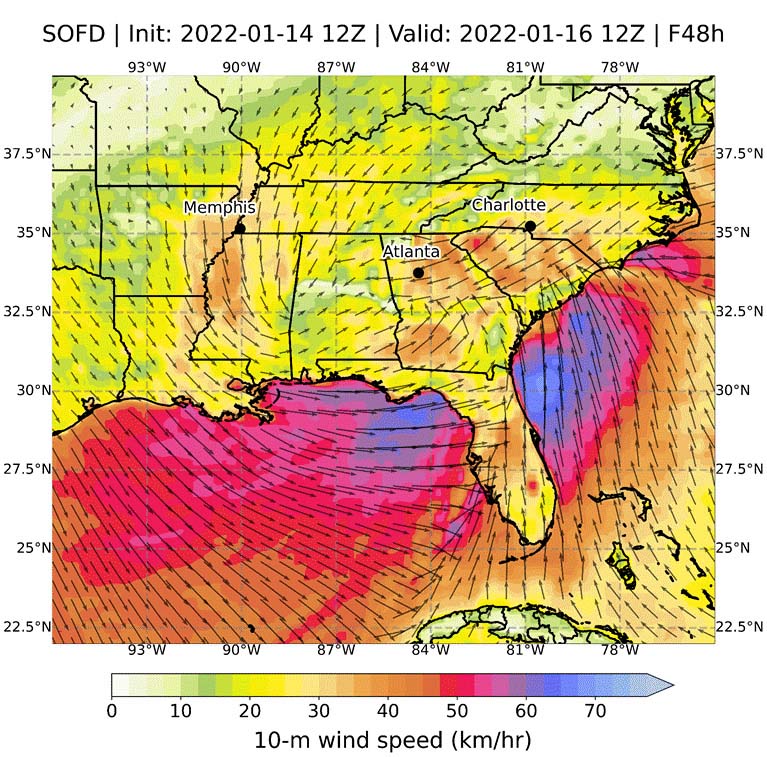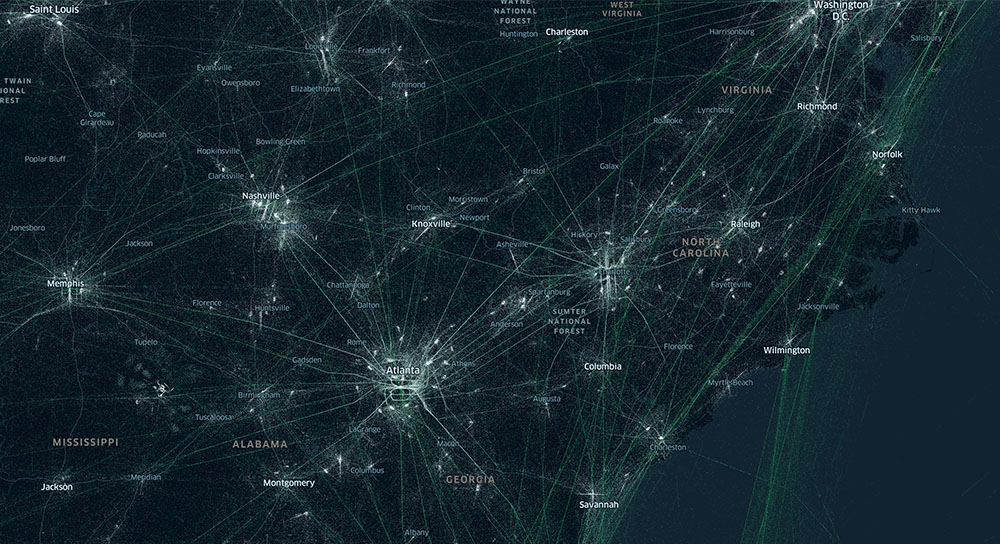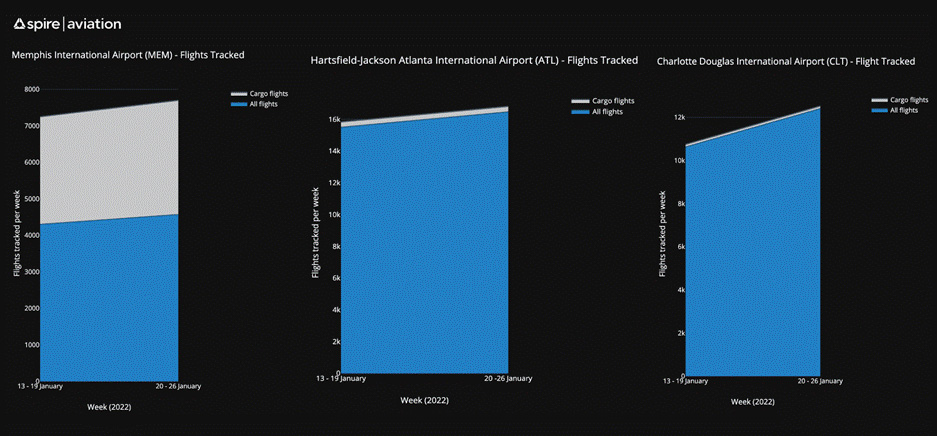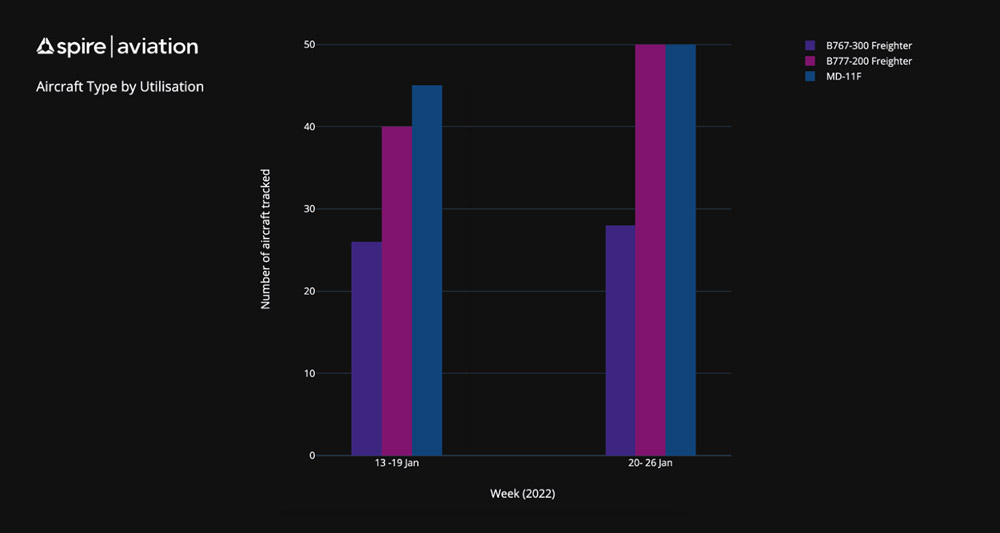How winter storms disrupt air cargo operations
Ever since the world’s very first airport (College Park Airport in the USA) unveiled its runaway back in 1909, operational managers understood the critical role that weather played in its functional performance.
However, since then the world has changed and witnessed several natural disasters of catastrophic levels, especially hurricanes that cause significant disruptions to airport operations. This has compelled airport managers to address the impact of weather via effective contingency plans and swift reallocation of resources.
Last year, Storm Izzy laid havoc in its wake across the American region in mid-January. Throughout the year 2022, 14 storms had been named and credited with wreaking havoc across countless American households. In this data story, the team at Spire tapped into its weather forecast and aviation data to examine the impact of Winter Storm Izzy on the air cargo supply chain.
To understand the context, take a look at the visual below that maps out American airports struck by hurricanes. Ranked by the capability to manage hurricane-related flight delays and cancellations, you can clearly denote that Newark Liberty International is the worst whilst the Hartsfield-Jackson Atlanta International is rated as the best. Hartsfield-Jackson Atlanta is classified as the busiest airport in the world and hence, one of the three airports within our focus in this analysis. The other two constitute Memphis International Airport and Charlotte Douglas International Airport as they’re located on the southern part of the USA that experienced Storm Izzy adversely.
Worst US airports for hurricane-related delays and cancellations
| Ranked worst to best | Airport |
| 1 | Newark, NJ: Newark Liberty International |
| 2 | New York, NY: LaGuardia |
| 3 | New York, NY: John F. Kennedy International |
| 4 | Houston, TX: George Bush Intercontinental/Houston |
| 5 | Washington, DC: Ronald Reagan Washington National |
| 6 | Dallas/Fort Worth, TX: Dallas/Fort Worth International |
| 7 | Fort Lauderdale, FL: Fort Lauderdale-Hollywood International |
| 8 | Philadelphia, PA: Philadelphia International |
| 9 | Boston, MA: Logan International |
| 10 | Baltimore, MD: Baltimore/Washington International Thurgood Marshall |
| 11 | Dallas, TX: Dallas Love Field |
| 12 | Orlando, FL: Orlando International |
| 13 | Houston, TX: William P Hobby |
| 14 | Miami, FL: Miami International |
| 15 | Washington, DC: Washington Dulles International |
| 16 | Fort Myers, FL: Southwest Florida International |
| 17 | Raleigh/Durham, NC: Raleigh-Durham International |
| 18 | Austin, TX: Austin – Bergstrom International |
| 19 | Tampa, FL: Tampa International |
| 20 | Charlotte, NC: Charlotte Douglas International |
| 21 | Pittsburgh, PA: Pittsburgh International |
| 22 | Nashville, TN: Nashville International |
| 23 | San Antonio, TX: San Antonio International |
| 24 | New Orleans, LA: Louis Armstrong New Orleans International |
| 25 | Atlanta, GA: Hartsfield-Jackson Atlanta International |
Source: InsureMyTrip and The U.S. Department of Transportation’s (DOT) Bureau of Transportation Statistics (BTS). InsureMyTrip ranked the on-time performance for the busiest airports in the Eastern US during hurricane season.
Crippling USA air systems that included air cargo and passenger transportation, Storm Izzy brought heavy snow and ice from the Northern Plains onto the southeastern regions and also included tornadoes in southwest Florida. This strong blizzard grounded over 1200 American flights, left a quarter of a million American residents without power, and caused approximately 300 road accidents in its wake.
Storm Izzy halted operations at busy south-eastern American airports

The above animation depicts Spire’s weather forecast model’s prediction that a strong, comma-shaped low-pressure system would strike the southeast US. This forecast animation was for 48 hours of the composite radar and indicates the potential reach and intensity of the forecasted precipitation. It reflects that certain geographical areas in this vicinity would experience severe thunderstorms and tornadoes (as Florida actually did). As stated, some of the busiest air hubs lie within this region and include:
- Memphis, a large cargo shipping center utilized by global entities such as FedEx as a primary distribution point
- Atlanta, the busiest airport in the United States by passenger traffic
- Charlotte ranked as the fifth busiest national airport in 2022
Powerful winds hindered aircraft takeoff and landing safety
However, there was another component to Storm Izzy that compounded the negative weather effect at these large airports – the threat of sustained high winds. Spire’s weather forecast anticipated heavy thunderstorms and sustained high wind speeds. The map below denotes Spire’s 48-hour forecast with sustained wind speeds as shown. All three airports highlighted were forecast to be struck by sustained wind speeds near or greater than 40 km/h.

Alone, these wind speeds would probably not have been powerful enough to affect air traffic so notably. However, when these sustained high wind speeds converged with heavy precipitation, the forces unleashed caused the cancellation and delay of thousands of flights across the three significant airports within the region: Memphis, Atlanta, and Charlotte. In addition to the winds, the storm system created a prolonged period of Low Instrument Flight Rules (LIFR) conditions.
All airports pay critical attention to wind speed, gust, and wind direction to make optimal decisions regarding runaway configurations for inbound/outbound aircraft operations. The authorities responsible for airport functionality define specific safety thresholds for such weather parameters that permit planes to land and take off safely. For Storm Izzy, wind speeds were predicted to be high enough to obstruct airports from operating at full capacity, thus stranding thousands of travelers and delaying/canceling over 7000 flights nationally.
Uncovering the effects of severe weather on air freight operations
Understanding the consequences of extreme weather events on air cargo operations is crucial to empower businesses to be able to make data-driven decisions and develop contingency plans to alleviate the risks. To shed more light on the impact of Storm Izzy on air traffic, here’s an analysis of Spire’s aviation data that compares flights during the week of the snowstorm and the week after. The visual below depicts the impact of the storm at each of these respective airports: Memphis, Atlantis and Charlotte.
 After Storm Izzy (20-26 Jan 2022)
After Storm Izzy (20-26 Jan 2022)Air traffic overview of southeastern United States
Apart from thousands of flights being canceled throughout the south-eastern region of America, a 3% decline in cargo flights was detected at Hartsfield–Jackson Atlanta International Airport whilst the Memphis International Airport witnessed a 6% drop in flights. Venturing towards the northern-eastern heart of the USA, Storm Izzy impacted the Newark Liberty International Airport and Louisville Muhammad Ali International Airport yet not as negatively as its southern counterparts.

Studying the combined number of cargo and passenger flights scheduled over the same period, it’s observed that flight density declined between 6%-14% across Memphis International, Hartsfield–Jackson Atlanta International, and Charlotte Douglas International Airport. The latter has been notably hit the hardest by Storm Izzy. Charlotte is a primary air and passenger hub with over an average of 1400 arrivals and 118,000 people traveling through per day. Storm Izzy affected more than 74 million people as it canceled thousands of flights whilst delaying hundreds of others. Similar to passenger flights, the winter storm disrupted air cargo operations as well by grounding several aircrafts and postponing delivery timelines.Leading global logistics and transport service providers experience a 30% decrease in aircraft utilization.
To truly gain an overall understanding of the impact of winter storms on air cargo daily operations, Spire’s team analyzed the top five cargo operators from Memphis, Atlanta, and Charlotte airports as well as the aircraft types commonly utilized by these operators to grasp the effect of Storm Izzy on the global air supply chain.
Major carriers experience 30% drop in air cargo flights
Let’s understand that global trade logistics is a highly complex and interconnected ecosystem. A weather-related delay at one point would require subsequent actors (ranging from trucks, warehouse, ports, railway services) to adjust their operational schedules accordingly. They would also have to ensure that they have the correct capacity to store the incoming cargo and have it available for the next stage of transport. Therefore, when a winter storm with the intensity equivalent to Storm Izzy left icy roads that were deemed dangerous to drive upon, it naturally hindered the transportation of goods from main cargo hubs that serviced international and domestic operations. The delays were further exacerbated by fallen trees and power lines that blocked primary road arteries and highways.
Putting the above into perspective, extensive air, road and rail services to main cities in the country that included port facilities link to the Hartsfield–Jackson Atlanta International Airport that connects cargo carriers with six different continents. During the stormy week of January 2022, three out of five operators, FedEx, Korean Air and Qatar Airways, experienced the consequences of Storm Izzy on their aircraft utilization. Korean Air and Qatar Airways operations were negatively impacted with cargo flights declining by over 30%. Considering that the Hartsfield-Jackson airport processes an average of 56,000 metric tons of cargo and mail on a monthly basis, even the most minute delays will have far-reaching effects down the air supply chain.
 After Storm Izzy (20-26 Jan 2022)
After Storm Izzy (20-26 Jan 2022)Hartsfield–Jackson Atlanta International Airport (ATL)
Soaring over to the Memphis and Charlotte airports, a similar trend is evident amidst cargo aviation operations at both the Memphis International Airport and at the Charlotte Douglas entity. The Memphis International Airportis the busiest cargo airport in North America and the second-busiest in the world. Home to major global logistical service providers, Storm Izzy had a particularly strong effect on the daily operations of two of the airport’s major cargo players: UPS and Atlas Air. Both cargo carriers respectively witnessed their daily operations within that week fall by almost half of their usual capacity.
 After Storm Izzy (20-26 Jan 2022)
After Storm Izzy (20-26 Jan 2022)Memphis International Airport (MEM)
Meanwhile, at the Charlotte Douglas International Airport that caters to over 30 airlines for domestic, regional and international passenger/cargo services, cargo operators felt the brunt of the winter storm with a 22% average decline in airport usage.
 After Storm Izzy (20-26 Jan 2022)
After Storm Izzy (20-26 Jan 2022)Charlotte Douglas International Airport (CLT)
When examining the influence of weather conditions on aircraft utilization, it is also necessary to analyze the impact on particular aircraft types. When factoring that in for vital air cargo players, it’s evident that the storm effected the longest-range twin-engine aircraft B777-200 freighter the most. Its utilization fell by over 20% at both the Atlanta and Memphis International Airport. Secondly, the American three-engine wide-body airliner McDonnell Douglas MD-11F was impacted the least.

Storms do not only cause loss in airport revenue yet cause infrastructural damages worth thousands of dollars. Often, it can take days, weeks or even up to months to rebuild. Apart from impacting flight schedules and safety, hurricanes can also cause power outages that add further chaos to the existing tumultuous environment. Factor in seasonal holidays and peak travel times under extreme weather conditions, it’s imperative for air supply service providers to be equipped with global, accurate weather and aviation insights to quickly assess the impact of these disruptions on their operations and make adjustments to minimize the damage, and ensure flight schedules are optimized and goods are delivered on time.
Get customized weather data for your business Explore space-based flight data and aviation insights
 Written by
Written by


